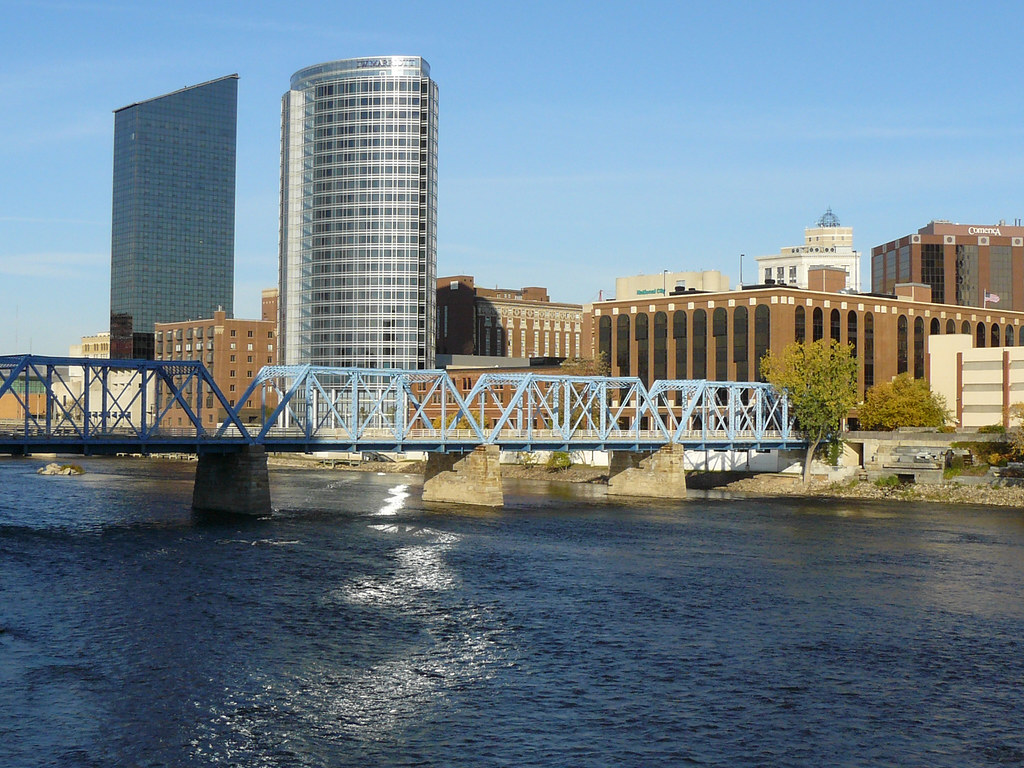The City of Grand Rapids Michigan
Contents

Grand Rapids is the second-largest city in Michigan and the biggest city in West Michigan. It is on the Grand River about 30 miles (48 km) east of Lake Michigan. As of the 2010 census, the city population was 188,040. In 2010, the Grand Rapids city had a population of 1,005,648, and the combined analytical area of Grand Rapids-Muskegon-Holland had a population of 1,321,557. Grand Rapids is the county seat of Kent County.
A historic furniture-manufacturing center, Grand Rapids is home to 5 of the world’s leading office furniture business, and is nicknamed “Furniture City”. The city and surrounding communities are financially diverse, based in the health care, info technology, automotive, aviation, and consumer items producing markets, amongst others.
Grand Rapids is the childhood house of U.S. President Gerald Ford, who is buried with his partner Betty on the grounds of the Gerald R. Ford Presidential Museum in the city. The city’s primary airport and among its highways are also called after him.
Grand Rapids Data
| Coordinates: 42°57′40″N 85°39′20″WCoordinates: 42°57′40″N 85°39′20″W | |
| Country | |
|---|---|
| State | |
| County | Kent |
| Founded | 1826 |
| Incorporation | 1850 |
|
Government |
|
| • Type | City Commission-Manager |
| • Mayor | Rosalynn Bliss |
| • City Manager | Mark Washington |
|
Area |
|
| • City | 45.35 sq mi (119.35 km2) |
| • Land | 44.43 sq mi (115.08 km2) |
| • Water | 0.88 sq mi (2.28 km2) 1.92% |
|
Elevation |
640 ft (200 m) |
|
Population (2010)
|
|
| • City | 188,031 |
|
• Estimate (2018)
|
200,217 |
| • Rank | 119th in US |
| • Density | 4,474.91/sq mi (1,727.77/km2) |
|
• Urban (2010)
|
569,935 (US: 70th) |
|
• Metro |
1,038,583 (US: 52nd) |
|
• CSA |
1,421,374 (US: 38th) |
| Demonym(s) | Grand Rapidian |
| Time zone | UTC-5 (EST) |
| • Summer (DST) | UTC-4 (EDT) |
| ZIP code |
49501, 49502, 49503, 49504, 49505, 49506, 49507, 49508, 49510, 49514, 49515, 49516, 49518, 49523, 49525, 49534, 49546, 49548, 49555, 49560, 49588, 49594
|
| Area code(s) | 616 |
| FIPS code | 26-34000 |
| GNIS feature ID | 0627105 |
| Website | www |
History
Over 2000 years back, people associated with the Hopewell culture inhabited the Grand River Valley. Later on, a tribe from the Ottawa River traveled to the Grand River valley, fighting three fights with the Prairie Indians who were developed in the area. The people later on divided, with the Chippewas settling in the northern lower peninsula, the Pottawatomies staying south of the Kalamazoo River and the Ottawa staying in main Michigan.
By the late 1600s, the Ottawa, who inhabited area around the Great Lakes and spoke one of the various Algonquian languages, moved into the Grand Rapids area and founded a number of towns along the Grand River. The Ottawa established on the river, which they called O-wash-ta-nong, or far-away-water due to the river’s length, where they “raised corn, melons, pumpkins and beans, to which they added video game of the woods and the fish from the streams”.
In 1740, an Ottawa man who would later be known as Chief Noonday and end up being the future chief of the Ottawa, was born. In between 1761 and 1763, Chief Pontiac checked out the area annually, gathering over 3,000 locals and asking them to offer to combat the British in Detroit, which would culminate into Pontiac’s War. By the end of the 1700s, there were an approximated 1,000 Ottawa in the Kent County area. Grand Rapids government employment.
Entertainment and performing arts
Grand Rapids has a number of popular concert locations in which various bands have actually carried out, including 20 Monroe Live, the DAAC, the Intersection, DeVos Performance Hall, Van Andel Arena, Royce Auditorium in St. Cecilia Music Center, Forest Hills Fine Arts Center, The Pyramid Scheme, and the Deltaplex.
The Schubert Male Chorus of Grand Rapids was founded by Henry C. Post on November 19, 1883; the chorus continues to carry out a variety of music.
The Grand Rapids Symphony, established in 1930, is the largest performing arts organization in Grand Rapids with a roster of about 50 full-time and 30 part-time artists. In addition to its own performance series, the orchestra under music director Marcelo Lehninger accompanies productions by Grand Rapids Ballet and Opera Grand Rapids, providing more than 400 performances a year.The Grand Rapids Barbershop Chapter Great Lakes Chorus is an all-male a cappella barbershop consistency chorus, consisting of quartets. It is one of the oldest chapters in the Barbershop Harmony Society (formally known as the Society for the Preservation and Encouragement of Barber Shop Quartet Singing in America, or SPEBSQSA). The Grand Rapids chapter organized on November 1, 1939, for quartet singers; it is credited for holding the very first society-sanctioned quartet contest in the “Michigan District” (now Pioneer District) in March 1941. In 1944 the Grand Rapids Chapter is credited with having the first International Quartet champions, “The Harmony Halls.” In 1947 the Great Lakes Chorus (then called the Grand Rapids Chorus) was founded. In 1953 the first International Chorus Competition was held, and the Great Lakes Chorus took First Place, the first “International Convention Championship Chorus,” under the direction of Robert Weaver. The chorus is still very active as a non-profit singing for neighborhood, competition, and contracted efficiencies.
Grand Rapids Ballet Company was established in 1971 and is Michigan’s only professional ballet business. The ballet company is on Ellsworth Avenue in the Heartside neighborhood, where it moved in 2000. In 2007, it broadened its center by adding the LEED-certified Peter Wege Theater.
Opera Grand Rapids, founded in 1966, is the state’s longest-running expert business. In February 2010, the opera moved into a brand-new facility in the Fulton Heights neighborhood.
A January 21, 2011 Newsweek post listed Grand Rapids as a “dying city” due to the fact that of its drop in population from 2000 to 2009. The Grand Rapids LipDub, launched May 26, was the first-ever citywide lip dub video; movie critic Roger Ebert explained it as “the greatest music video ever made”. The video held the world record for biggest lip dub for 2 years and has amassed over 5 million views on YouTube; PRNewswire awarded its manufacturers the “Earnie Award” for Best Use of Video in Social Media.
Grand Rapids is also home to Art Prize, the largest art exposition in the U.S. Art Prize began in 2009 with the over 200,000 visitors and has since doubled the number of visitors it gets each year. Artprize gets numerous worldwide visitors each year and is still growing with over 1,500 entries from 48 nations across 200+ venues in 2015.
Education
K– 12 public education is provided by the Grand Rapids Public Schools (GRPS) in addition to a number of charter schools. City High-Middle School, a magnet school for academically talented trainees in the cosmopolitan region run by GRPS, is constantly ranked amongst the country’s leading high schools. Grand Rapids is likewise home to the earliest co-educational Catholic high school in the United States, Catholic Central High School. National Heritage Academies, which runs charter schools across several states, has its head office in Grand Rapids.
The Main Branch of the Grand Rapids Public Library: the Ryerson Building, its earliest wing, opened in 1904.
The Cook-DeVos Center for Health Sciences, on Grand Rapids’ “Medical Mile,” becomes part of Grand Valley State University’s Pew Grand Rapids campus. The academies Calvin Theological Seminary, Grand Rapids Theological Seminary, and Puritan Reformed Theological Seminary are in Grand Rapids. Thomas M. Cooley Law School, a private institution, also has a campus in Grand Rapids. The for-profit professional school Davenport University, a private, non-profit, multi-location university with 14 schools statewide, has its main school simply outside Grand Rapids.
As for public tertiary institutions, Grand Rapids Community College (GRCC) preserves a school downtown and facilities in other parts of the city and surrounding area. Grand Rapids Animal Control
Grand Rapids, MI Zip Codes
49503 49504 49505 49506 49507 49508 49509 49512 49519 49525 49534 49544 49546 49548

